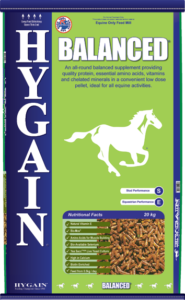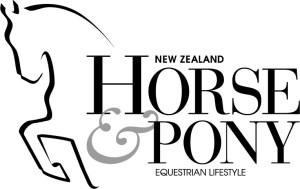
Horses, like all animals, have a range of nutrient requirements to meet their daily needs. If these minimum requirements are not met, the horse may experience deficiency symptoms.
The severity of these symptoms may depend on the degree of the deficiency, and the time period over which the deficiency exists.
Clinical deficiencies
A clinical deficiency is present when there are readily observed or measured symptoms. The easiest example is the deficiency of energy (calories) in the diet; the more severe the deficiency, the faster the horse will lose weight. If a horse is losing 100g per day, the loss will take some time to be visible. But over the course of six months, the horse would lose 18kg, or about a full body condition score. Over the course of a year, the horse would be almost 40kg underweight or would have dropped from a body condition score of 5 to a 3.
If the horse is getting sufficient calories, but is deficient in protein or essential amino acids, the body condition might appear okay, but the hair coat might get dull, the hoof quality might deteriorate and the muscle tone might be lost. This is common for horses who are on pasture alone, which has adequate energy content, but is short in amino acids or other nutrients.
Sub-clinical deficiencies
A sub-clinical deficiency may be the result of a small deficiency over a period of time, and may also result in a decreased immune response, decreased reproductive efficiency and decreased performance.
Mineral and vitamin imbalances are the most common sub-clinical deficiencies in horses.
Zinc excess might produce symptoms consistent with copper deficiency such as improper cartilage development in foals.
Phosphorus excess might create an inverted calcium-to-phosphorus ratio (less than 1:1) and can produce nutritional secondary hyperparathyroidism or “Big Head’ disease, as well as other bone issues.
Phosphorus deficiency is most common in horses being fed poor quality pasture and hay, which results in weakened bones.
Selenium deficiency might cause loss of mane and tail hairs and sloughing of the distal portion of the hoof (hoof wall separation).
Vitamin A deficiency may develop if dried, poor-quality roughage is fed for a prolonged period. If body stores of vitamin A are high, signs may not appear for several months and can result in impaired reproduction as well as brittle hooves.
Vitamin D deficiency is unlikely to develop as long as the horse is fed sun-cured hay and/or is exposed to sunlight. Prolonged confinement of horses offered only limited amounts of sun-cured hay may result in reduced bone calcification, stiff and swollen joints, stiffness of gait, irritability and reduced serum calcium and phosphorus.
In order to avoid these deficiencies we must first understand where these nutrients come from in the equine diet.
Pasture deficiencies
Horses by nature are grazers; they have a large hindgut specifically for digesting fibre. They are designed to eat for about 18 hours a day. In the wild, horses grazed on whatever shrubs, grass and weeds were available as they moved with their herds, and these roughages had varying nutritional values. Today we have access to improved grass species and better pasture management practices that provide high quality pastures with increased nutrient availability and longevity. Hay is a direct reflection of the pasture nutrient availability and conditions at time of cutting.
Pasture composition can still be highly variable. It is affected by plant species, soil fertility, water availability, climate, stage of growth and management practices. Applying fertilizer to the soil increases, yield, protein and nutrient content of forages subsequently grown. High temperatures generally increase the concentration of fibre in forages, which has led to a subsequent decline in digestibility.
When there is a decrease in leaf proportion there is typically also a decrease in crude protein (CP) concentration and an increase in the concentration of non-digestible fibre. This can also lead to decreased palatability of forages. Temperate grasses tend to have higher digestibility than tropical grasses. Digestibility declines as forage matures; the most effective way of avoiding low digestibility is by maintaining forage in a young vegetative stage of growth by regular cutting or grazing.
Hay and pasture should always make up the majority of the horse’s diet. Access to adequate amounts of good quality pasture and hay can provide horses with minimal nutritional requirements – such as non-exercising, mature horses – with most of their nutritional needs, especially energy and protein. Pasture and hay however, are typically always deficient in several trace minerals such as copper, zinc and selenium, so it is important to supplement these deficiencies.
The diet illustrated in figure 1 may produce some sub-clinical issues over time. The diet in figure 2 shows one option of correcting these issues by adding a low intake vitamin and mineral concentrate such as HYGAIN® BALANCED® or HYGAIN® SPORTHORSE®.


Feeding commercial feeds higher in energy and protein therefore only becomes necessary when horses do not have adequate access to good quality pasture and hay, or there are increased demands on the horse, such as pregnancy, lactation, growth or performance.
Commercial feeds
Even if you are feeding a commercial feed as well as hay and pasture to your horse you will not necessarily avoid deficiencies. Following the feeding directions outlined on the product is critical in order to supply adequate nutrients from the feed. If the feed states a 3kg feeding rate for a 500kg horse, and you only feed 1.5kg, then you are halving all of the nutrients supplied by the product. This may be fine for the energy portion of the feed, but it will also cut in half the amount of vitamins and mineral provided by the product. Just because a horse receives enough energy from a product and is in good body condition does not mean that his diet is adequately fortified.


Get a free personalised diet analysis for your horse: Fill out the five easy step Hygain Nutrikey form at the link below, and have a nutrition consultant assess your horse’s diet.
http://www.hygain.com/au/nutrikey






